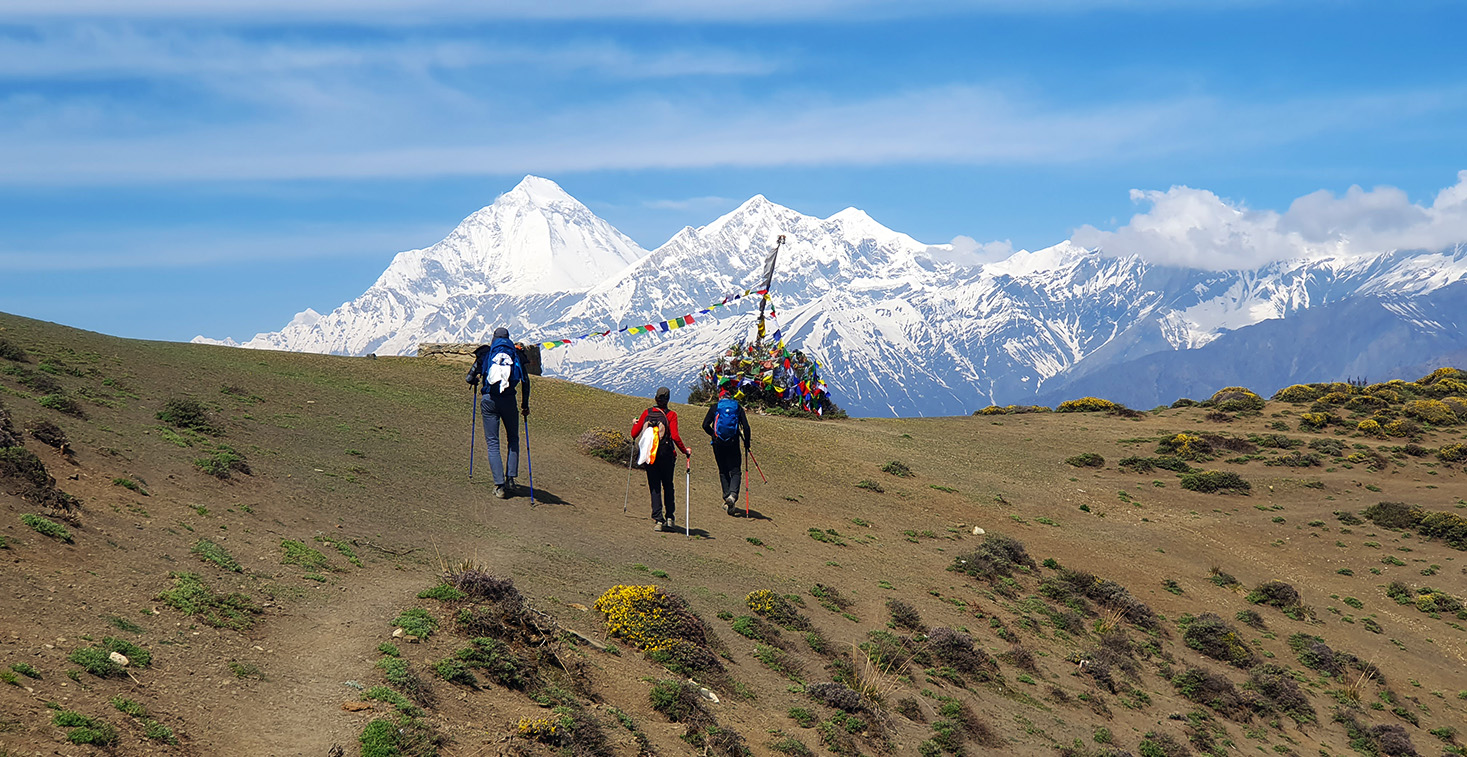
Upper Mustang Trekking Guide
Upper Mustang Trekking Guide – The Upper Mustang Trek is one of those rare opportunities to realize just how amazing this Forbidden Kingdom of Mustang, also called Lo, lies off the beaten track. The Upper Mustang Trek is a beautiful path leading through striking semi-arid desert scenery with exciting rock formations, deep canyons, and towering scenery that is seemingly endless.
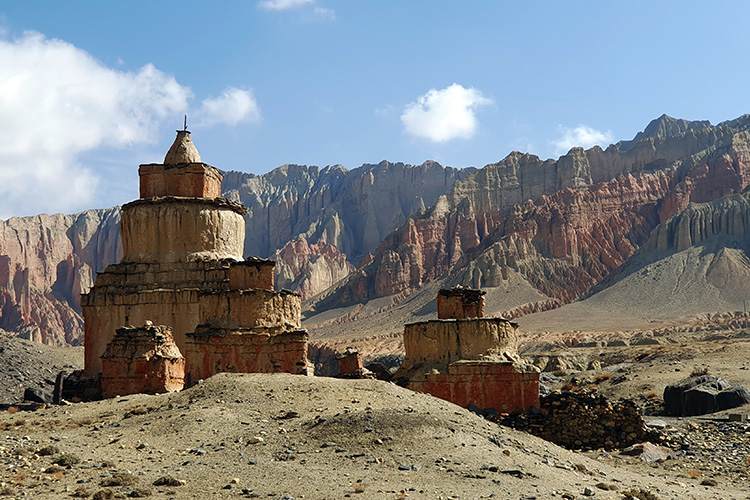
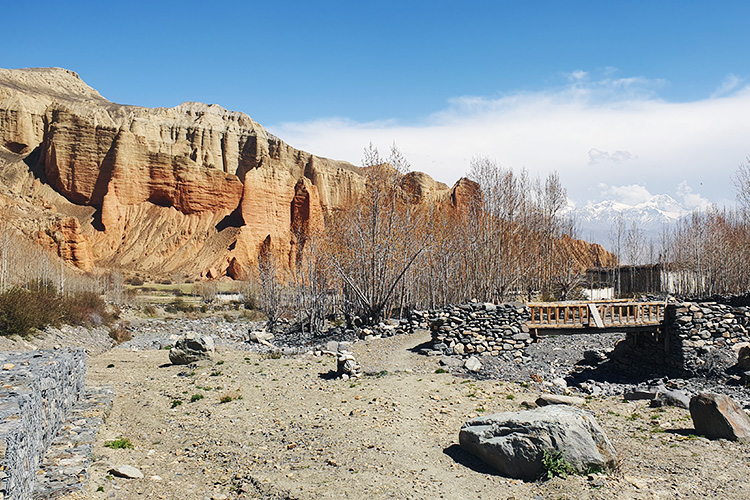
This area, beyond the Himalayas, was alienated from the rest of the world for many years. In this duration, however, it was able to grow and harvest its own culture and traditions, somewhat similar to those practiced in Tibet. This region, sharing a border with Tibet, has its people, culture, and terrain highly influenced by the Tibetan touch. For centuries, it had its own kingdom with Lo Manthang as its capital.
The other main highlights of Lo Manthang include a number of ancient monasteries, traditional villages with dotting primer houses, and architectural caves sitting high up on the cliff.
Upper Mustang is one of those very few destinations in the world that have a rich heritage of mythical and profound legends. It also has strong Buddhist culture, thousands of years of protected historical sites, and open-hearted friendly locals. This region is not an exception in terms of modernization impacts. Still, the uniqueness of cultural and traditional aspects is what shocks visitors. People living in mountains struggle to sustain their history and culture within their natural environment, and we can feel their spirits.
The Upper Mustang trek leads one through one of the driest areas in Nepal, offering unique treeless land, rocky trails, and exotic views of Nilgiri, Annapurna, Dhaulagiri, and many more. Although considered one of the driest areas that receive minimum rainfall, life thrives on it, and the grandeur is of a different class. Highlands discharge delirious mountain rivers that splash this vast land.
The Upper Mustang Trek in Nepal combines cultural explorations with breathtaking landscapes. Emphasis is on exploration of the mysterious realm of Mustang’s historic Buddhist monarchy. This 18-day program is an amalgam of trekking and cultural experience perfectly. A tranquil haven, standing deep in the forest, is far away from the hustle and bustle that civilization has to offer. Embrace the Himalayan mountains and experience the enchanting aura of Mustang.
“Mountains are the beginning and the end of all natural scenery.”
By John Ruskin
Table of Contents
- What makes the Upper Mustang Trek a worthwhile experience?
- The best season for trekking in Upper Mustang?
- Where is Upper Mustang?
- Food and accommodation during the Upper Mustang Trek
- Why Upper Mustang region being restricted?
- What about AMS in Upper Mustang?
- Upper Mustang Trek Difficulty Level
- Packing List for the Upper Mustang Trek
- Trekking Permit for Upper Mustang Trek
- Travel insurence for Upper Mustang Trek
- Useful Tips for Upper Mustang Trek
- The Best Upper Mustang Trek Itinerary
What makes the Upper Mustang Trek a worthwhile experience?
A trek to Upper Mustang is a rare privilege. Here, you will be introduced to the life of true mountain people who, for centuries had very little contact with the rest of Nepal and have kept their rich cultural heritage intact. Until recently, the Government of Nepal officially recognized their king.
Many aspects of the trek to Upper Mustang have similarities with trekking in Tibet, since it is actually a part of the Tibetan plateau, geographically. Geographically, the district of Mustang was an independent kingdom until 1950 and another remaining independent kingdom within Nepal’s borders. Now, the only remaining king, the Raja of Mustang, lives in Lo Manthang, the acknowledged historical capital.
The land of Upper Mustang was opened to non-Nepali trekkers about fifteen years ago, and even today, it is a highly restricted area. Trekkers entering the land of Upper Mustang need a different kind of trekking permit, and they are required to have a certified guide accompanying them. In every sense of the word, Upper Mustang is totally different from the rest of the country.
What is the best season for trekking in Upper Mustang?
Upper Mustang is a place you may be looking out for if you want an ideal trekking option in Nepal during these three summer months. Due to its positioning in the rain shadow of the Annapurnas, the weather is clear and dry in the Upper Mustang during this time of the year. Interestingly, the summer months are also comparatively peaceful. You will get the best teahouses. Spring and autumn are considered to be the peak season of the year.
Tiji Festival falls in May, and many trekkers make their trip coincide with this traditional festival. This three-day celebration is done at the place of the old palace of the king of Mustang. The people from different regions come to Lo Manthang, Upper Mustang, to participate in this festival. Similarly, it is quite possible to trek in the region of Upper Mustang during the winter season, where it is necessary that you will be well-prepared in order to have such a trek with all the proper equipment.
Where is Upper Mustang?
It is previously called the Kingdom of Lo, and the Upper Mustang lies on the northern part of the Mustang District in Nepal. Since it was just a restricted kingdom, closing until 1992, this helped preserve this area and its traditional languages pertaining to the Tibetic family. Hence, this is considered one of the best-preserved parts of the world. This may be attributed to the fact that Tibetan culture has been relatively better preserved from the outside world owing to its isolation. Tourism, animal husbandry, and trade are the mainstays of the economy in Mustang.
The Upper Mustang region makes up the northern two-thirds of the Mustang District, which lies in the Gandaki Province of Nepal. It consists of three rural municipalities. Upper Mustang falls within the rain shadow area of the Himalayas, something that makes it receive very little precipitation throughout the whole year. The result is a landscape of bare deserts, deep canyons, and towering cliffs. Others include historic villages, monasteries, palaces, and ancient caves.
Thak, a southern third of the district, includes the home of the Thakali indigenous people. They are the indigenous speakers of the Thakali language and have a culture closely tied to both Tibetan and Nepalese traditions. Upper Mustang is not as populated as Lower Mustang. It is generally filled with green forests, fertile valleys, and typical Nepalese villages. Muktinath is one of the most famous pilgrimages in this area, which is greatly revered by Hindus and Buddhists alike.
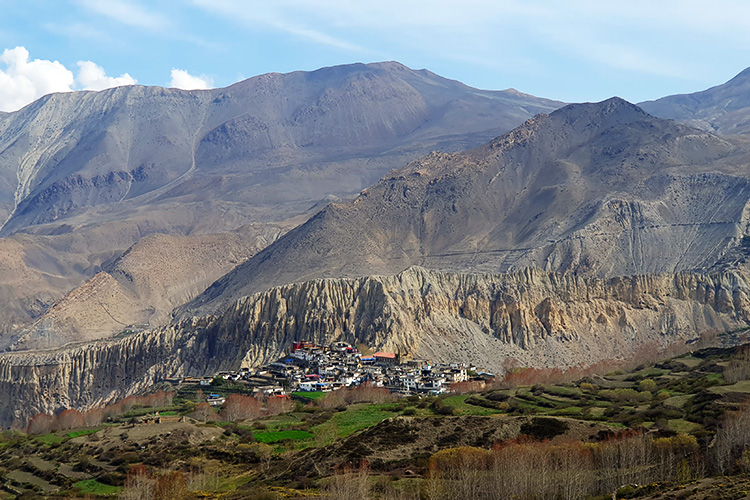
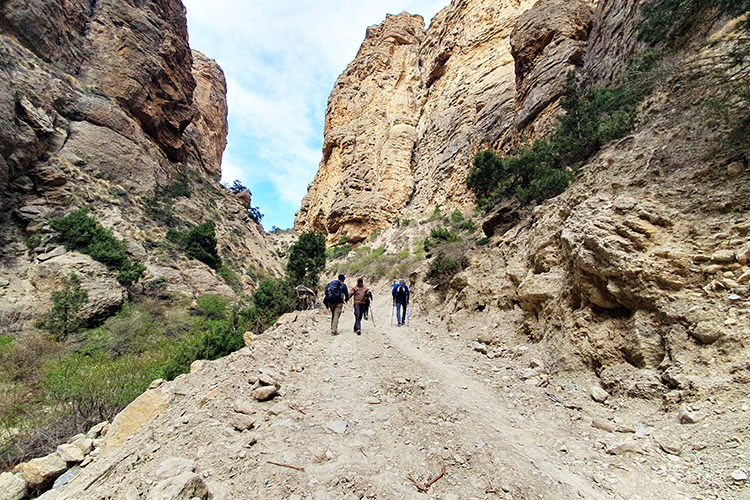
Food and accommodation during the Upper Mustang Trek
Accommodations during the trek are in simple, rustic lodges, operated by local Mustang families. Every lodge has a big common room where there is usually a big stove that makes the room warm and comfortable and very inviting. Bedrooms usually have beds with mattresses, pillows, and a blanket, but the rooms are usually not heated.
The lodges generally have gas-powered showers, but most of them have sit-down flush toilets, although many can also be fitted out with squat toilets. Food on the Upper Mustang trek is great and a good mix of local Nepali/ Tibetan and western food. Dal bhat with rice is an old classic local filling and tasty meal. Sometimes, other things can be found on the trail. You can also find a price guide for Nepal here.
Why Upper Mustang region being restricted?
Until 1992, the Upper Mustang was a restricted demilitarized area. This is one of the factors that have contributed to the region’s exceptional preservation, keeping it quite secluded from the outside world. This valley runs in a south-to-northern direction right from the top of the Annapurna Circuit down to the border with Tibet. Thus, most of the local people still communicate with each other in traditional dialects of Tibetans.
What about AMS in Upper Mustang?
The symptoms of AMS usually set in a couple of hours after arrival at high altitude. Symptoms may include nausea, shortness of breath, headache, and inability to exercise. The feeling of fatigue can dampen the excitement you felt before it all started to go downhill. You may feel such symptoms as not being able to sleep, dizziness, or a bad headache. It is also possible to experience loss of coordination, not being able to walk well, or tightened chest. If it comes to HAPE or HACE, one may be confused, experience difficulty breathing even at rest, and may turn not to be able to walk. Acute Mountain Sickness, AMS can occur not only in treks to the Everest Base Camp or other high peaks but also at other locations.
Your symptoms could worsen with much higher altitudes. You’ll know what we are referring to if you have seen the movie Everest. Fortunately, you are only trekking while those guys are climbing. Various scores are available to assess altitude sickness. Guides are trained in their use and experienced in the provision of immediate treatment. While many people may develop mild symptoms, it is possible to avoid further deterioration in most instances. Having been aware of such symptoms you may take appropriate precautions to stay safe at high altitudes.
Upper Mustang Trek Difficulty Level
Like any other trek, proper fitness level is necessary for the Upper Mustang trek. The difficulty level of the Upper Mustang trip can be expressed as moderate; therefore, it can be done by trekkers of all levels. However, it does have many challenges that may test your abilities.
In the course of the journey, you will cross high passes with steep ascents and descents. You will also be able to see gorgeous mountains with breathtaking views, which would uplift your spirit. The Kingdom of Lo will be a refreshing relief to fatigue. We offer an upscale Jeep Safari for visiting Upper Mustang through our Upper Mustang Jeep Tour.
Packing List for the Upper Mustang Trek
The gear is your best friend when going mountainous. Quite literally, it’s not where you’re going; it’s what you’re carrying that counts. Under extreme conditions, gear could mean the difference between life and death. A reasonable amount of time, having the right gear decides between a good experience and a bad one. You get your tickets booked and your guide is ready to welcome you in Nepal. You, on the other hand, seem to arrive with a heavier backpack than what is desired or recommended; a jacket that might not keep you warm enough; and a pair of shoes that are bound to give you a number of blisters. Quite a sad situation it is. Get the right gear and equipment to help you enjoy your trek in Mustang.
Below we present you a basic comprehensive packing list suitable for any trek in Nepal including your trek on the Mustang region:
- Duffel Bag
- Rucksack with Rain Cove Daypack
- Hiking Boots
- Sandals or Shoes
- Hiking Socks
- Trekking Poles
- Inner Socks
- Thermal Baselayer
- T-Shirts
- Fleece Pullover or Jacket
- Light Weight Thermal Tops
- Waterproof Jacket
- Sports Bra for Her
- Hiking Shorts
- Hiking Pants
- Waterproof Pants
Obviously there is more you can pack and bring along. Everyone is different, so everyone has their own needs.
Trekking Permit for Upper Mustang Trek
As Upper Mustang falls under the category of a restricted area, to visit the place, permits will be required. The region shares an open border with Tibet, which forms a part of China. To ensure that the travel will preserve and protect the ancient Tibetan Buddhist culture and the Bon religion, all foreign tourists must be on a Restricted Area Permit. Furthermore, a permit is necessary because the trail also passes through the Annapurna Conservation Area.
To enter the restricted area of Upper Mustang, each person must possess a permit, which is called the RAP. The RAP costs 500 USD per person for the first 10 days and then USD 50 per person per day. Additionally, for the Annapurna Conservation Area, every foreigner needs to be in possession of an ACAP permit; this costs 30 USD per head. On the other hand, the SAARC Nationals are required to pay less for the same. The above quotations are prices. In the Restricted Area Permit, everything concerning the trekker is written in detail, from the route taken up to mentioning the contact people in case of any emergencies. Hence, this trek doesn’t need a TIMS card.
For the requirement, you need to provide a photocopy of your passport, three passport-sized photos, your travel insurance policy number, information about your daily itinerary and the route you will take to trek. The trekking agency will arrange everything about the trip.
The permits are neither transferable nor refundable. One who is below 10 years doesn’t need to pay the entrance fee. Make sure you have both the permits with you all the time and show them at the respective check posts. The permit will be checked at Chele check post, which is considered to be the entrance of Upper Mustang.
Travel insurence for Upper Mustang Trek
Having travel insurance is important if you are traveling to foreign countries or any high-risk area. Upper Mustang lies in the far-flung and restricted area of Nepal, and limited vehicle accessibility has only a few health posts on the trail. The trek of Upper Mustang is considered quite safe, but remembering that altitudes reach 4000m/13,123ft, Altitude Sickness has to be kept in mind. For sudden accidents or illnesses, medical treatment may not be timely and proper. Sometimes, helicopter rescue could be needed, which may turn out to be very expensive.
Travel insurance against any kind of accidental incident related to this trek is highly recommended. On buying a travel insurance policy, you are supposed to make a proper selection of an insurance company and the plan according to which high-altitude treks are covered up to 5,000m/16,404ft along with the cancellation policy as well. You are supposed to let your insurance company know all the details about your day-to-day itinerary, maximum altitude, trekking region, emergency contact, and many other things concerning this regard.
Useful Tips for Upper Mustang Trek
As it is semi-arid, plenty of water intake is essential in Upper Mustang. It’s best to try and avoid buying mineral water bottles; instead, carry a bottle with an inbuilt filter or water purification pills and refill from communal drinking taps.
The equipment for trekking or gears can easily be obtained by renting or buying from the trekking rental stores available either in Thamel, Kathmandu, or in Pokhara. Indeed, it is a great option rather than carrying big luggage from home.
One would always recommend taking along the toilet paper, sanitizer, and paper soap for sanitation purposes.
One should preferably carry Nepalese Rupees with them while traveling to this remote upper Mustang, since ATM, banks, currency exchange, or even QR payments are minimal. It is preferred that one gets the currency from Kathmandu or Pokhara itself before heading on the trip.
It is also said that in order to avoid altitude sickness, one should walk slowly and not hurry to ascend. One can also consult with the doctor on any precautionary medications to be taken like Diamox or any altitude sickness medication.
Some of the things you should think of trying out while you are in Mustang include Dal Bhat, Tibetan Bread, and Tibetan noodles. This is because they are also easy to get, it’s tasty, and cheaper in comparison with the rest of the items on the menu of the tea houses. These foodstuffs will fill your stomach entirely.
Snacks are pretty pricey at higher altitudes; it is recommended to bring some dry fruits, energy bars, and cookies from Pokhara that you can have during your trek.
It is mandatory to take permission from concerned authorities before operating or flying the drone.
The Best Upper Mustang Trek Itinerary
The following itinerary commences and concludes in the city of Kathmandu. Your trip can be organized from Pokhara too based on your preferences.
To travel from Kathmandu to Pokhara, there are option of driving (6 to 7 hours) or 30 minutes flight. From Pokhara we take a short flight to Jomsom and start our trek and leads to the legendary Kagbeni village. On the following day, proceed towards the gateway to Upper Mustang, which is Chele. The trail takes you through Syangboche, Ghami, and Tsarang villages, and eventually leads to the former Kingdom’s capital at Lo Manthang. The distance between Mustang and Pokhara is 146km.
After taking a day to acclimatize and go on an excursion at Lo, proceed to the ancient villages of Yara, Tangbe, and Tetang en route to Muktinath, a sacred temple for both Hindus and Buddhists. After that, trek back to Jomsom and then take a scenic flight to return to Pokhara. Wrap up the incredible trek by returning to the city of Kathmandu via car.
Outline Itinerary:
- Day 1: Take a drive from Kathmandu (1,400m/4,592ft) to Pokhara (800m/2,625ft) 6-7hours (200 km/124 miles)
- Day 2: A flight to Jomsom (2,700m/8,856ft) and hike to Kagbeni (2,810m/9,217ft) 25 minutes flight, 3-4 hours trek
- Day 3: Trek to Chele (3,050m/10,004ft) 5-6 hours trek
- Day 4: Trek to Syanbochen (3,475m/11,398ft) 6-7 hours trek
- Day 5: Trek Syanbochen to Ghami (3,520m/11,546ft) 5-6 hours trek
- Day 6: Trek to Tsarang (3,620m/11,874ft) 5-6 hours trek
- Day 7: Trek to Lo-Manthang (3,730m/12,235ft) 3-4 hours trek
- Day 8: Excursion of Lo Manthang
- Day 9: Trek to Yara (3,838m/12,589ft) 6-7 hours trek
- Day 10: Trek to Tangbe (3,240m/10,628ft) 7-8 hours trek
- Day 11: Trek Tangbe to Tetang (3,067m/10,060ft) 8-9 hours trek
- Day 12: Trek to Muktinath (3,800m/12,464ft) 7-8 hours trek
- Day 13: Trek to Jomsom (2,700m/8,856ft) 5-6 hours trek
- Day 14: Return back to Pokhara by flight (800m/2,625ft)
- Day 15: Travel back to Kathmandu









